Scientific Name
Abelmoschus esculentus (L.) Moench
Synonyms
Abelmoschus bammia Webb, Abelmoschus longifolius (Willd.) Kostel., Abelmoschus officinalis (DC.) Endl., Abelmoschus praecox Sickenb., Abelmoschus tuberculatus Pal & Singh, Abelmoschus tuberculatus var. deltoidefolius T.K.Paul & M.P.Nayar, Hibiscus esculentus L., Hibiscus esculentus var. praecox (Forssk.) A.Chev., Hibiscus hispidissimus A.Chev., Hibiscus longifolius Willd., Hibiscus praecox Forssk. [1] [8]
Vernacular Name
Scientific Classification
| Malaysia | Kacang bendi, sayur bendi, kacang lender [2] |
| English | Okra, lady’s finger [2] |
| India | Vendai (Tamil); benda (Telagu); bhendi, dhanrhas (Bengali) [2] |
| Indonesia | Kopi arab [2] |
| Saudi Arabia | Bamia [2] |
| Africa | Mbinda (Swahili) [2] |
| France | Gombo commun, gombo, gumbo, bamie-okra [2] |
| Portuguese | Quiabeiro, Quabo, Bamia [2] |
| Bulgarian | Bamia [9] |
| German | Essbarer eibisch, eßbarer Bisameibisch [9] |
| Chinese | Ka fei huang kui [9] |
| Philippines | Okra, saluyot a bunga (Ilocano), haluyot (Ifugao) [13] |
| Burma | you-padi [13] |
| Cambodia | pôôt barang [13] |
| Laos | khüa ngwàng [13] |
| Thailand | krachiap-khieo (central), krachiap-mon (central), bakhua-mun (northern) [13] |
| Vietnam | ậu bắp, bụ bắp, mướp tây [13] |
| Zimbabwe | derere [18] |
| Kingdom | Plantae |
| Division | Magnoliophyta |
| Class | Magnoliopsida |
| Order | Malvales |
| Family | Malvaceae |
| Genus | Abelmoschus |
| Species | esculentus |
| Binomial name | Abelmoschus esculentus |
Geographical Distributions
Okra is a native and originated from tropical Africa and was then propagated in North Africa, Mediterranean, Arabia and India by the 12th century BC. It was cultivated by Europeans as early as 1216 A.D., and has now been introduced and cultivated into most warm tropics, subtropics and warmer temperate zones. It is one of the oldest cultivated crops and is presently grown in many countries and is widely distributed from Africa to Asia, southern Europe and America. It is particularly popular in Brazil, India, Spain, Thailand, the Philippines, southern USA, Turkey, and West Africa. [10][11][12]
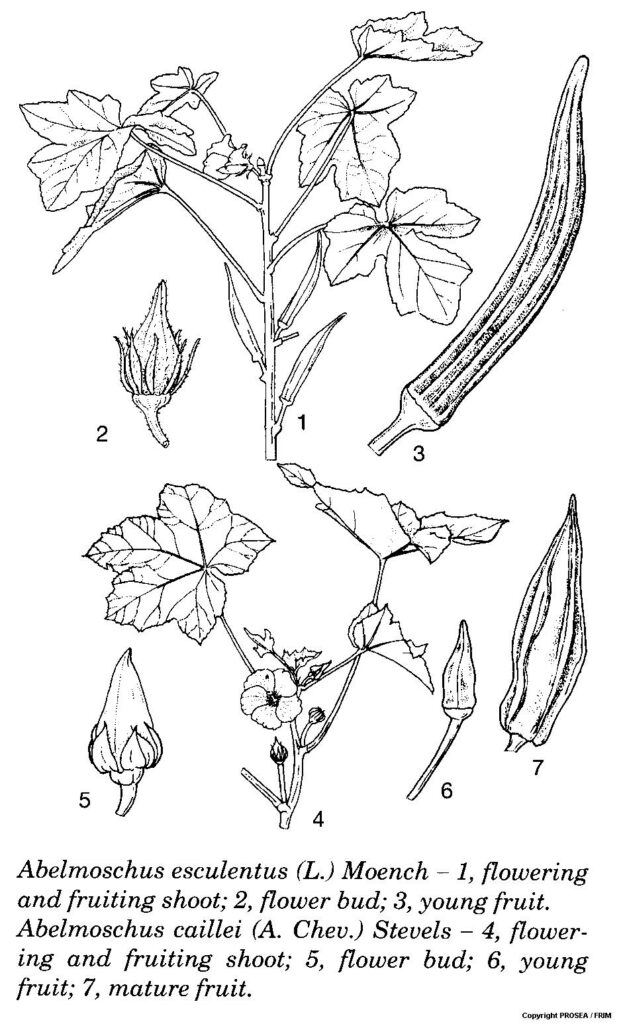
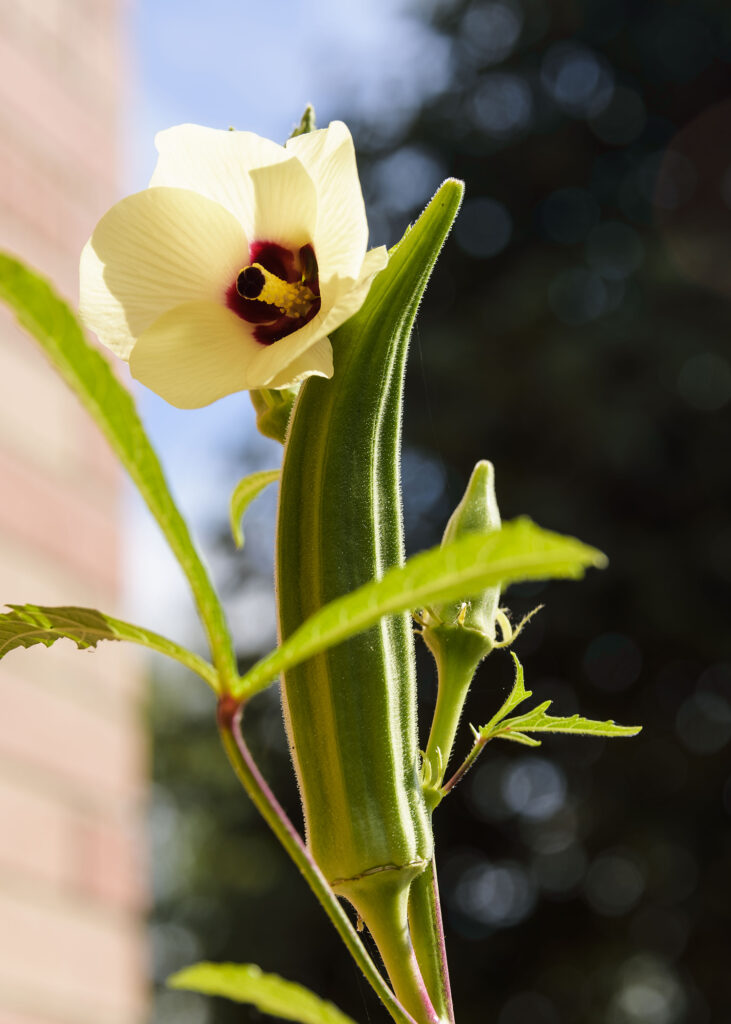
Botanical Description
Abelmoschus esculentus (L.) Moench > Leaves
The leaves are arranged spirally, leaf-blade up to measure 50 cm in diametre and more or less deeply with 3-, 5- or 7-lobed. The petiole is up to measure 50 cm long, slender stipules that are up to measure 20 mm long and often split to the base. [3]
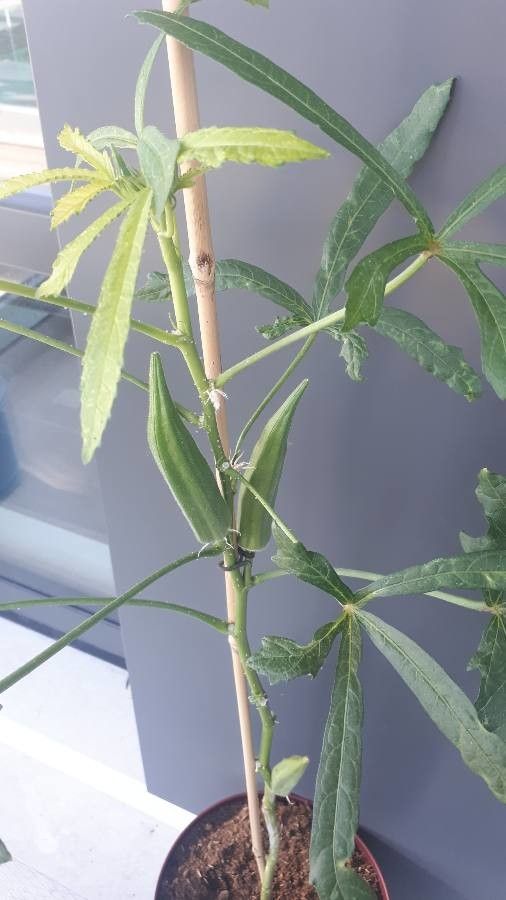
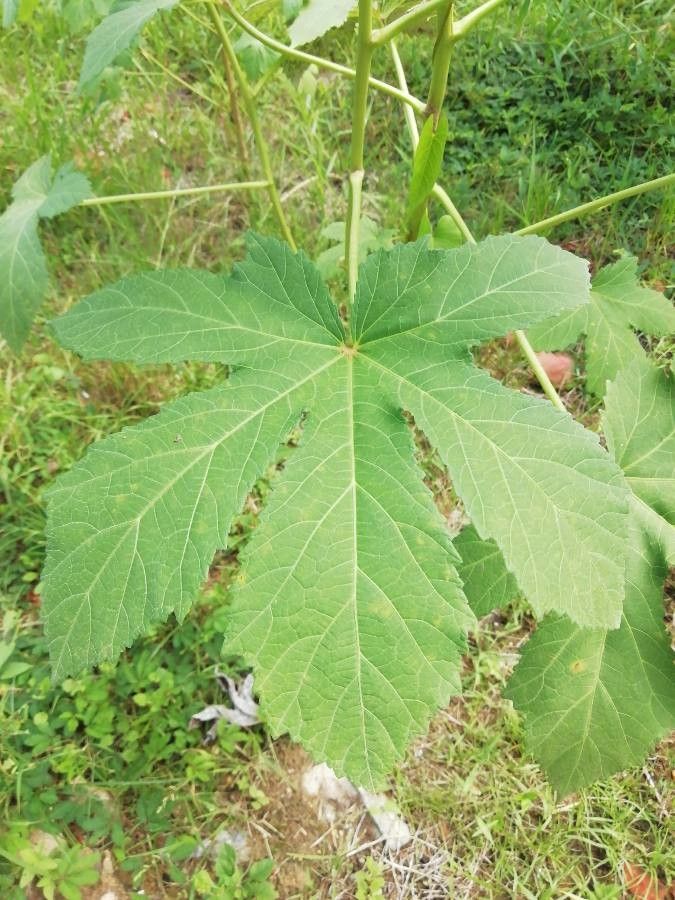
Abelmoschus esculentus (L.) Moench > Reproductive morphology > Flowers
The flowers are solitary in the leaf axils or in pseudoracemes by reduction of the upper leaves. They are self-fertile. The corolla is with 5 obovate petals where each is measure about 3-8 cm long and wide and yellow with a dark purple in colour at the centre. The pedicel is up to measure 3 cm long in flower and up to measure 7 cm long in fruit. The 7-15 epicalyx segments are free, linear segments and with a size of measuring 5-25 mm (length) x 0.5-3 mm (width). The measure of 2-6 cm long sepal is spathaceous, splitting on one side during the expansion of the petal and adnate to and fall with the petal. [3] [18]
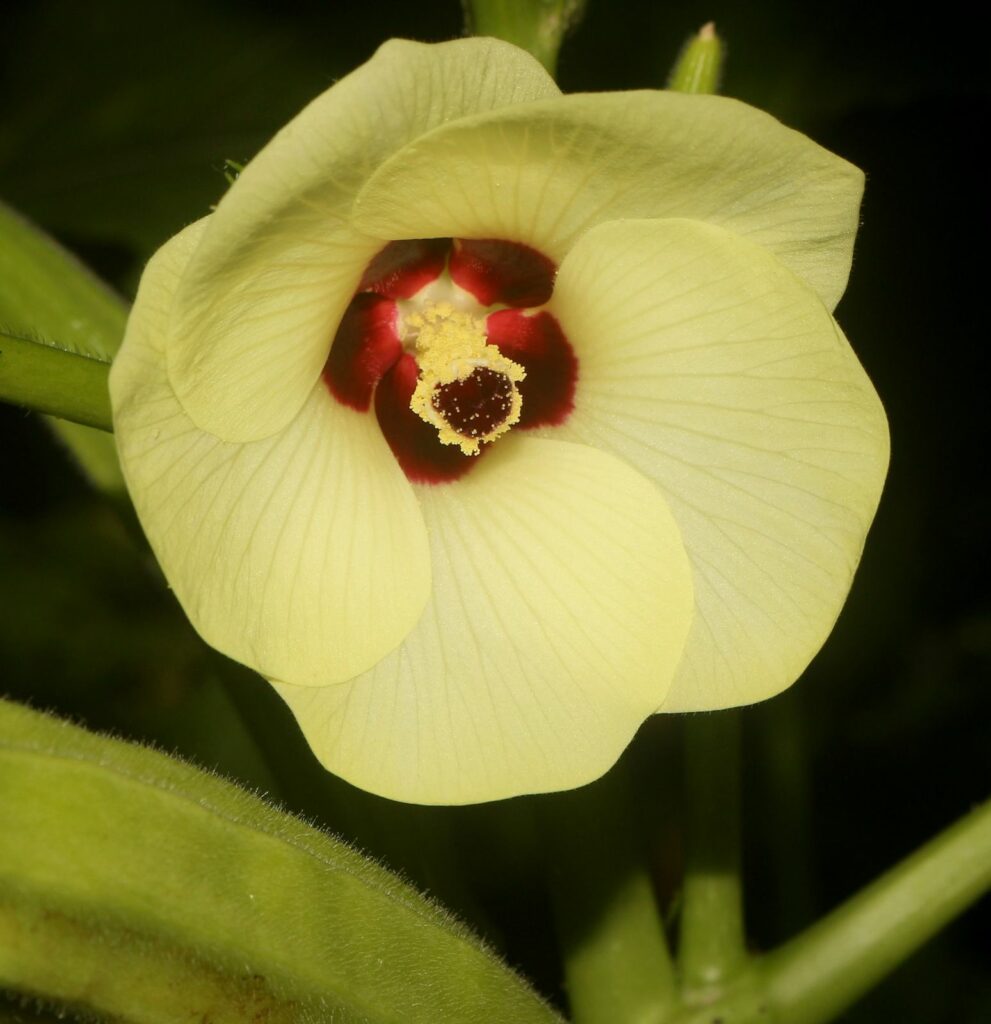
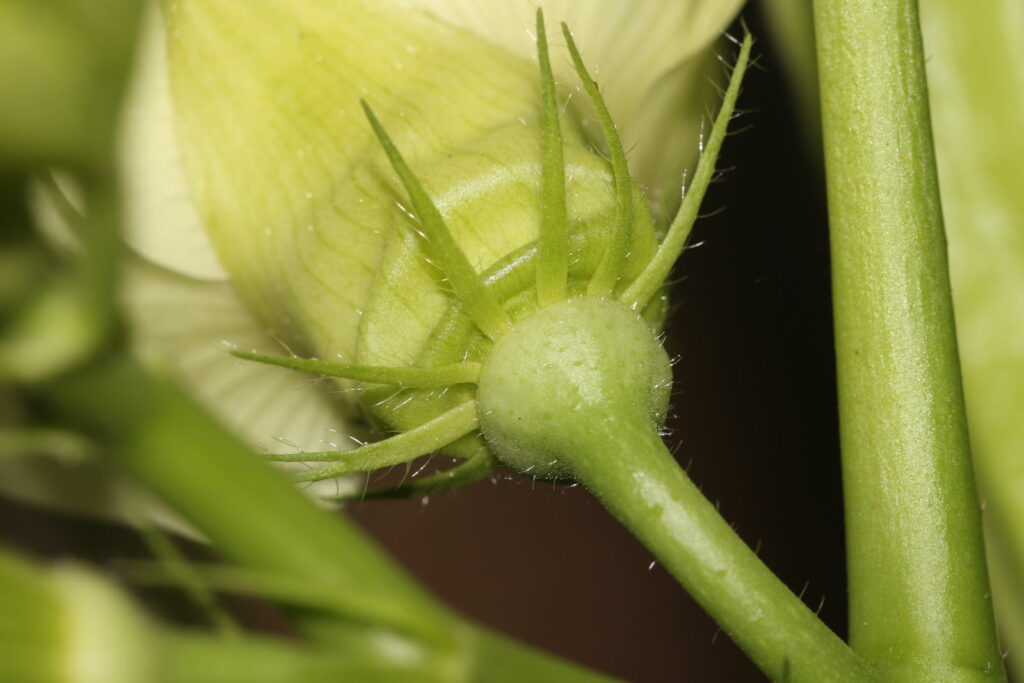
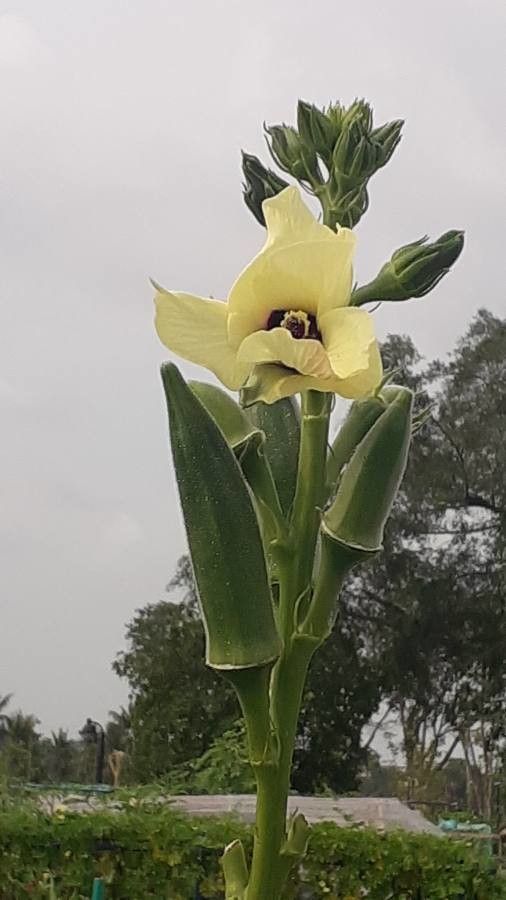
Abelmoschus esculentus (L.) Moench > Fruit
The fruit is a cylindrical to pyramidal capsule, could be 5-35 cm long, 1-5 cm in diametre, ellipsoid to very narrowly ellipsoid, completely, partially or not loculicidal, green, greenish-purple or completely purple when young and brownish when mature. At first appressed-setose and pubescent, later glabrescent. [3]
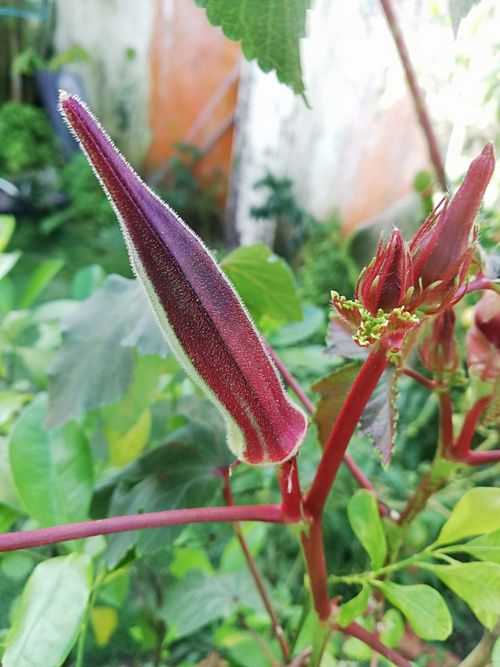
Fruit of Abelmoschus esculentus (L.) Moench. Copyrighted by Woojs.
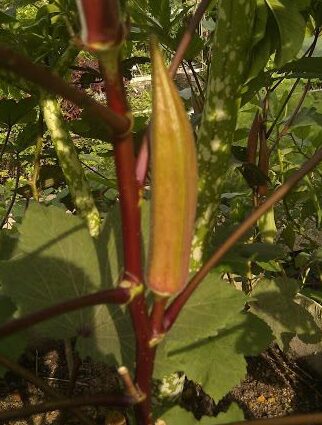
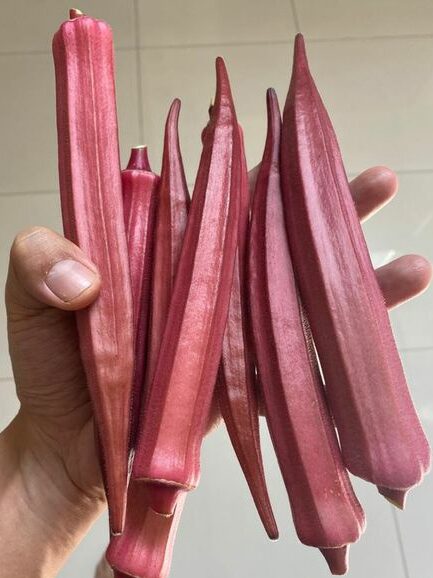
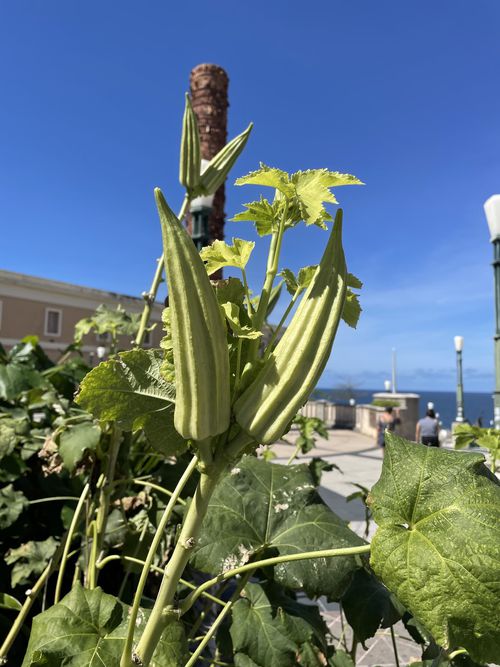
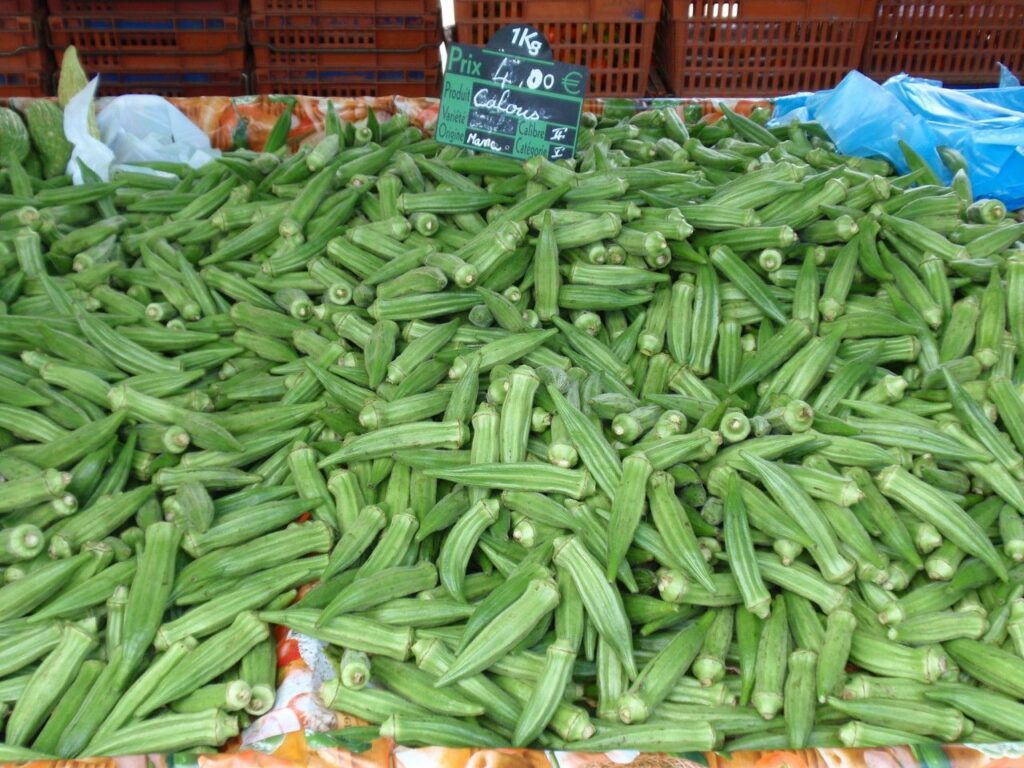
Abelmoschus esculentus (L.) Moench > Seeds
The seeds are numerous, spherical in shape, measuring about 3-6 mm in diametre and blackish in colour. Germination is an epigeal. [3]
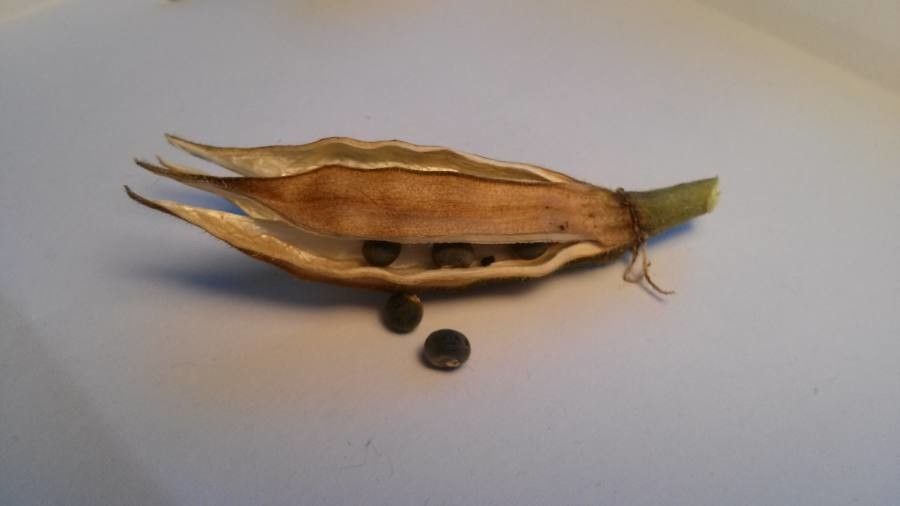
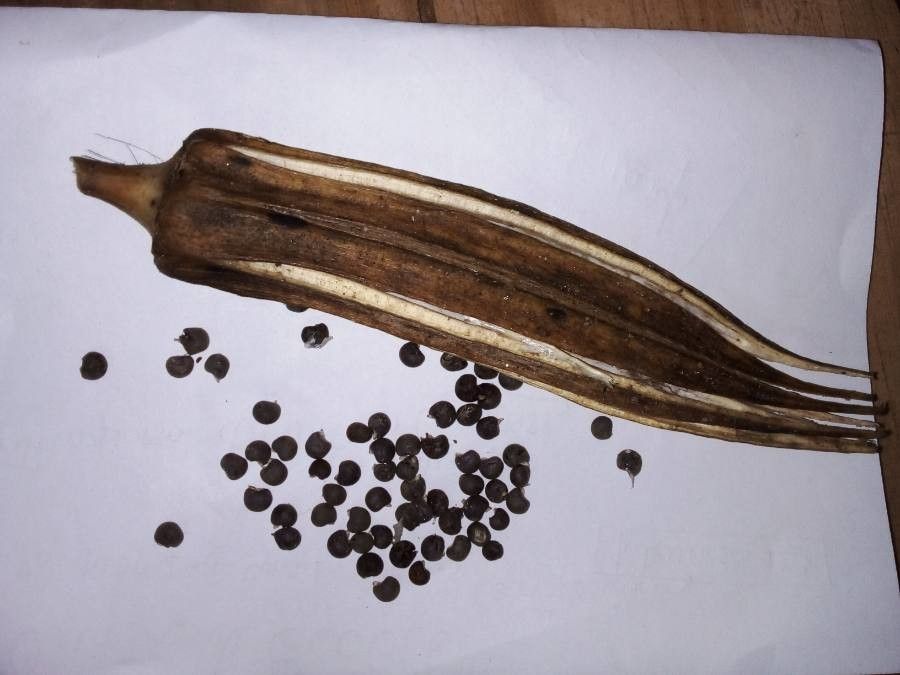
Cultivation
Soil Suitability and Climate Requirement
A. esculentus needs temperatures above 20°C for normal growth and development. Germination percentage and speed of emergence are optimal at 30-35°C. Flower initiation and flowering are delayed at higher temperatures (positive correlation between temperature and number of vegetative nodes). A. esculentus is a short-day plant, but its wide geographical distribution (up to latitudes of 35-40°) indicates that cultivars differ markedly in sensitivity. Flower initiation and flowering are hardly affected by daylength in popular subtropical cultivars such as ‘Clemson Spineless’ and ‘Pusa Sawani’. Most tropical cultivars show quantitative short-day responses, but qualitative responses also occur. The shortest reported critical daylength is 12 hours 30 minutes. [3]
Common okra tolerates a wide variety of soils, but prefers well-drained sandy loams, with pH 6-7 and a high content of organic matter. [3]
Field Preparation
Production of Planting Materials
Most farmers harvest seed from their own local cultivar. The easiest way to keep the seed is to leave it in the pods. Seed weight varies from 30-80 g/1000 seeds. To soften the hard seed coat, the seed is often soaked in water or chemicals prior to sowing. The seed is usually dibbled directly in the field (1-3 seeds per hole). Optimum plant densities are in the range of 50000-150000 plants/ha. When the plants are about 10 cm tall, they are thinned to one plant per hole. [3]
Field Planting
Commercial okra growers usually practise sole cropping, and prefers the early, homogenous introduced cultivars. In traditional agriculture, farmers grow their okra landraces in home gardens orin fields with other food crops. Germination and initial growth are improved greatly by cultural practices that lower soil temperature e.g. mulching, watering before the hottest part of the day, ad sowing on ridge sides least exposed to direct sunlight. [3]
Field maintenance
Water management
Under humid tropical conditions a full-grown crop consumes about 8 mm of water per day. Some farmers practise ratoon cropping. A ratoon crop flowers soon after cutting, but usually results on poor quality fruit with a high percentage of bent fruits. [3]
Pest and Disease Control
The most serious fungal diseases of okra in Africa are damping-off (Macrophomina phaseolina, Phythium aphanidermatum, Rhizoctonia solani), vascular wilt (Fusarium oxysporum), Cercospora blight( Cercospora abelmoschi, Cercospora malayensis) and powdery mildew (Erysiphe cichiracearum, Oidium abelmoschi). Okra mosaic virus (OkMV) transmitted by flea beetles (Podagrica) is widespread in Africa but damage is much less important that that caused by okra leaf curl disease (OLCV), transmitted by whitefly (Bemisia tabaci). Whitefly is also the vector of yellow vein mosaic virus (BYVMV), a major cause of crop failure in Asia. These viruses can only be controlled through control of the vectors. Damage by nematodes of the genus Meloidogyne constitute a major problem, which is avoided by crop rotation (e.g. with cereals) and by large applications of organic manure. [3]
Important pests are fruit and stem borers (Earias spp. and Heliothis spp., Pectinophora gossypiella), flea beetles (Podagrica spp.) and jassids (Empoasca spp.). Chemical control is hazardous because crop harvesting is frequent. Common okra is in general more seriously affected by pests than West African okra. [3]
Harvesting
The earliest types of common okra are ready for first harvest at 7 weeks after sowing. Fruits should be harvested when 7-8 days old. Earlier picking depresses yields because of low fruit weight but delayed picking depresses marketable yields because over-aged fruits become fibrous. Okra fields are therefore harvested at intervals of 2-3 days. The minimum frequency is once a week but then fruits if all sizes have to be picked. [3]
Postharvest handling
Fresh okra can be transported quite easily in bulk and kept for a few days without much less of quality. Dried okra is an important product in West Africa. Although usually sliced transversally, longitudinal slicing has been observed in Nigeria. Such slices dry well at the edges but start fermenting from the middle creating a unique flavour. Some countries have a small canning and freezing industry. [3]
Okra mucilage can be obtained by grinding plant material, removing waxes and fat with ether and alcohol, suspending the purified material in water, filtering and concentrating the filtrate. [3]
Estimated cost of production
No documentation
Chemical Constituent
A. esculentus has been reported to contain 12,13-epoxyoleic acid; 9-hexadecenoic-acid; alanine; alpha-tocopherol; arginine; ascorbic-acid; ash; aspartic-acid; calcium; carbohydrates; copper; cyanidin-3-glucoside-4′-glucoside; cyanidin-4′-glucoside; cystine; folacin; gamma-tocopherol; glutamic-acid; glycine; gossypetin; gossypol; histidine; iron; isoleucine; leucine; linoleic-acid; lysine; magnesium; manganese; methionine; mufa; myristic-acid; niacin; oleic-acid; oxalic-acid; palmitic-acid; pantothenic-acid; pectin; pentosans; phenyalanine; phosphorus; phytosterols; potassium; proline; protein; pufa; quercetin; riboflavin; serine; sfa; sodium; starch; stearic-acid; sugar; sulfur; thiamin; threonine; tryptophan; tyrosine; valine; vit-b-6; zinc. [2][4][5]
Plant Part Used
- Fruit [6]
Edible green capsule (pod) of okra fruit (harvested when immature; after 3-5 days of development) and characterized by their slimy mucilage and usually consume as vegetable. Okra pods are also reported for their rich nutritional compositions [18][19][20]and are frequently consumed either after boiling, frying, or cooking.
Traditional Use
The fruit of A. esculentus is considered an emollient, demulcent and diuretic with stimulant and a vulnerary activity. The seeds on the other hand is considered antispasmodic, cordial, stimulant and sudorific. [6][7] The mucliaginous preparation of the pod is used in treatment of chronic dysenery while the mucillage rich roots with strong demulcent activity makes good remedy for gastritis. The fruit is used as a cure for haemorrhoids. [6][7]. According to Tuekish folk medicine, fresh okra fruit used in wound healing treatment.
The fruit boiled in milk is used to treat cough. A decoction of the fresh fruits is given for fever and catarrhal ailments. [6] When gonorrhoea and syphilis was introduced into Asian society by the western colonialist, the local traditional practitioners found the remedy in A. esculentus. They made used of the green pods to treat ardoe urinae, dysuria, irritability of the genito-urinary canal and in particular gonorrhoea. In the Malay Peninsula the root infusion is used to treat syphilis. [6][7]
The mucilaginous preparation made from the pods is used as a plasma replacement or blood-volume expander. In Latin America the leaves and seeds are folk remedies for tumour. In Nepal they use the juice of the roots to treat cuts, wounds and boils. [6][7]
Preclinical Data
Pharmacology
Antioxidant activity
The chemical composition of A. esculentus showed that it contained some antioxidants within it. Adelakun et al. found that by roasting the seeds at 160oC for 10-60 minutes they could increase the antioxidant activities significantly [4]. Sipahi et.al found that aqueous and ethanolic extracts of okra fruits exhibited antioxidant activity with significant protective effect against hydrogen peroxide (H2O2)-induced damage in human dermal fibroblast (HDF) cells by diminishing the Malondialdehyde (MDA) level [14]. Wahyuningsih et.al found antioxidant activities of okra pods by comparing free radical scavenging activity against DPPH and FRAP assays using methanol extract of okra pods. For DPPH assays, methanol extract of okra pods showed the highest antioxidant activity with an IC50 value of about 35.21 µg/mL which can be considered as very strong activity (IC50 lower than 50 µg/mL[16]). The antioxidant activity of the methanol extract was further assessed in a lead acetate-induced nephrotoxicity model (mice) which showed the nephroprotective potential of the extract with decreased cell damage, epithelial thickness and the diameter and percentage of necrotic cells in the proximal tubule. Nephroprotection is also presented as reduction in serum creatinine and blood urea nitrogen level (effective dose 50 – 200 mg/kg)[17].
Antiulcer activity
Lengsfeld et.al studied the effects of various extracts from young fruit of A. esculentus on the adhesiveness of Helicobacter pylori to gastric mucosa. They found that pretreatment of the bacteria with a fresh juice preparation inhibited bacteria adhesion almost completely. Lyophilization and reconstitution of an extract solution reduced this effect while a purified highly acidic subfraction was high antiadhesive qualities. Heat denaturation of fresh juice or protein precipitation reduced the antiadhesive properties. These indicates that both carbohydraytes and protiens play an important role in this actions. They concluded that this antiadhesive qualities were due to a combination of glycoproteins and highly acidic sugar compound making up a complex three-dimensional structure that is fully developed only in the fresh juice of the fruit. The active fractions did not show inhibitory effects on bacterial growth in vitro. [5]
Anti-Inflammatory activities
Mahdavi et.al conducted a systematic review on preclinical studies and found the concentrations of inflammatory mediators including CRP, IL-1β, IL-6, and TNF-α mainly showed a consistent downward trend after treatment with okra in the majority of preclinical (7 of 13 in vitro and 13 of 16 animal) studies. The findings proposed the potential of okra to lower CRP, IL-1β, IL-6, and TNF-α [15]. Sipahi et. al found highest dose (5 mg/mL concentration) of ethanolic extracts from okra fruits has displayed a potent anti-inflammatory activity by a significantly reduce nitric oxide on LPS-induced RAW264.7 cells. This significant reduction (36.10 + 5.56% and 38.95 + 5.92% respectively) manifested by ethanolic extract of Kilis and Aegean’s okra (Harvest field of the specimen okra harvested in Turkey for the research) was equal to indomethacin (38 +5.92%), a reference drug [14].
Toxicity
Hairs on the plant can cause itching and contact dermatitis. Dried seeds may contain poisonous substances which are removed by cooking. Gossypol has been reported. [6]
Clinical Data
No documentation
Poisonous Management
No documentation
References
- The Plant List. Ver1.1. Abelmoschus esculentus (L.) Moench. c2013 [updated 2012 Mar 23; cited 2016 Apr 21]. Available from: http://www.theplantlist.org/tpl1.1/record/kew-2609574
- Dr Duke’s Phytochemical and Ethnobotanical Databases. Cucumis sativus (Cucurbitaceae). [homepage on the Internet] US Department of Agriculture, Agricultural Research Service; c1992-2016 [updated 2016 Jun 02; cited 2016 Jun 27]. Available from: http://www.ars-grin.gov/cgi-bin/duke/farmacy2.pl
- Grubben GJH, Denton OA, editors. Plant Resources of Tropical Africa 2. Vegetables. Leiden, Netherlands: Backhuys Publishers, 2004; p. 25
- Adelakun OE, Oyelade OJ, Ade-Omowaye BI, Adeyemi IA, Van de Venter M. Chemical composition and the antioxidative properties of Nigerian Okra Seed (Abelmoschus esculentus Moench) Flour. Food Chem Toxicol. 2009;47(6):1123-1126.
- Lengsfeld C, Titgemeyer F, Faller G, Hensel A. Glycosylated compounds from okra inhibit adhesion of Helicobacter pylori to human gastric mucosa. J Agric Food Chem. 2004;52(6):1495-1503.
- Duke JA, DuCellier JL. CRC handbook of alternative cash crops. Boca Raton, Florida: CRC Press, 1993; p. 1–3
- Peter KV, ed. Underutilized and underexploited horticultural crops. Volume 2. New Delhi: New India Publishing, 2007; p. 212
- Abelmoschus esculentus (L.) Moench [Internet]. Worldfloraonline.org. [cited 2022 Mar 8]. Available from: http://www.worldfloraonline.org/taxon/wfo-0000510862.
- Abelmoschus esculentus (L.) Moench [Internet]. sciname finder. [cited 2022 Mar 8]. Available from: https://www.sciname.info/Default.asp
- Hill AF. Economic Botany A textbook of useful plants and plants products. 1st ed. Maidenhead, England: McGraw Hill Higher Education; 1937; p. 402
- Kochhar SL. Tropical crops: A textbook of economic botany. Oxford, England: Macmillan Education; 1987.
- JNilesh J, Ruchi J, Vaibhav J, Surendra J. A review on: Abelmoschus esculentus. Minerva Endocrinol [Internet]. 2012;1(3):84–9. Available from: https://pharmacia.ipsgwalior.org/artical/vol1_issue3_2.pdf
- Abelmoschus esculentus (PROSEA). (2016, April 25). PlantUse English, . Retrieved 07:52, March 8, 2022 from https://uses.plantnet-project.org/e/index.php?title=Abelmoschus_esculentus_(PROSEA)&oldid=220266.
- Sipahi H, Orak D, Reis R, Yalman K, Şenol O, Palabiyik-Yücelik SS, Deniz İ, Algül D, Guzelmeric E, Çelep ME, Argin S. A comprehensive study to evaluate the wound healing potential of okra (Abelmoschus esculentus) fruit. Journal of Ethnopharmacology. 2022 Apr 6;287:114843.
- Mahdavi AM, Javadivala Z, Ahmadian E. Effects of Okra (Abelmoschus esculentus L.) on inflammatory mediators: A systematic review of preclinical studies. Food & Function. 2022.
- Sakai T. Biomarkers of lead exposure. Industrial health. 2000;38(2):127-42.
- Wahyuningsih SP, Savira NI, Anggraini DW, Winarni D, Suhargo L, Kusuma BW, Nindyasari F, Setianingsih N, Mwendolwa AA. Antioxidant and nephroprotective effects of okra pods extract (Abelmoschus esculentus L.) against lead acetate-induced toxicity in mice. Scientifica. 2020 Mar 25;2020.
- Schippers RR. African indigenous vegetables: an overview of the cultivated species. Natural Resources Institute/ACP-EU Technical Centre for Agricultural and Rural Cooperation; 2000; p.103-118
- Grubben GJ, Tindall HD, Williams JT. Tropical vegetables and their genetic resources. 1977; p.15
- Romdhane MH, Chahdoura H, Barros L, Dias MI, Corrêa RC, Morales P, Ciudad-Mulero M, Flamini G, Majdoub H, Ferreira IC. Chemical composition, nutritional value, and biological evaluation of Tunisian okra pods (Abelmoschus esculentus L. Moench). Molecules. 2020 Oct 15;25(20):4739.
Update : 24 March 2022


